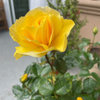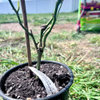I know that pyrethrin comes from daisy and since feverfew is a daisy or chrysanthemum, it contains pyrethrin. So, does the pyrethrin have to be extracted from the plant to work as an insecticide? I have seen no diminution in the numbers of thrips and aphids in my garden since I have feverfew growing, nor have I noticed less bees, but I am told by an agriculture professor that feverfew could cause my bee population to decrease since bees do not like it, not necessarily, he says, kill them.
Where is Mike Rivers on this?
(Just added some trivia here for your Sunday smiles. Flirtwort? It was surely named such by a married man who had fathered the child of a single woman, you think?)
Feverfew contains a number of toxins, terpenes, and is one of several sources of the insecticide, pyrethrum. Pyrethrum or pyrethron comes from the Greek, pyre, meaning fire. Medieval medicine classified a plant's use by 'temperature' and 'moisture'. In 1597, John Gerard said of this plant, "Feverfew doth manifestly heat, it is hot in the third degree, and drie in the second; it clenseth, purgeth, or scoureth, openeth and fully performeth all that bitter things can do." (The Herbal, 1633 ed.)
Gerard reiterated the ancient use of feverfew, "Dioscorides [first century]...teacheth, that it is profitably applied to Saint Anthonies fire, to all hot inflammations, and hot swellings, if it be laid unto, both leaves and floures....that the pouder of Feverfew drunke with Oxymell, or syrup of Vineger, or wine...draweth away flegme and melancholy...it is good for them that are giddie in the head....for such as be melancholike, sad, pensive, and without speech."
Feverfew was mainly considered a feminine remedy and called Matricaria for its action upon the matrix or womb. In the 'polite' language of the Sixteenth Century, Gerard wrote of its use as an abortifacient, "It is a great remedie against the diseases of the matrix (unwed motherhood); it procureth womens sicknes with speed; it bringeth forth the afterbirth and the dead childe, whether it bee drunke in a decoction, or boiled in a bath...." Women were taking an insecticide internally and this use was alluded to in another common name, flirtwort.
Henriette's Herbal plant photos has a great photograph of feverfew (Tanacetum parthenium (L.) Sch.-Bip). To view the photograph, click on the link:








patricianatOriginal Author
olga_6b
Related Discussions
I thought Rotenone-Pyrethrins is suppose to be safe?
Q
An organic spray for Aphids and other insects on roses
Q
Any organic solutions to get rid of carpenter bees?
Q
Attracting Beneficial Insects to Your Landscape
Q
debnfla8b
reg_pnw7
patricianatOriginal Author
LITTLEQUEEN6944_YAHOO_COM